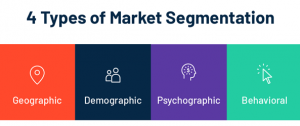Customer segmentation is essential for your market promotion. It ensures you provide services to stay in demand for all segments of your audience. Here’s a complete guide on the notion of customer segmentation, its impact on business and possible ways of how to make the best of it.
What is Customer Segmentation?
In two words, segmentation is the process of dividing customers into several groups based on certain criteria. It ensures the individual approach for everyone in your audience, offering different values for different people. This requires a clear understanding of what a particular customer or a group needs, and this is where segmentation comes to the rescue.
Why divide customers?
We can’t sell a product or a service at the same price for everyone, as it doesn’t bring the same value. Males and females of different ages think differently, and as more customers’ needs your business covers, the more profit it gets.
Let’s say you sell toothpaste. Everyone uses it everyday, so it seems that there is no problem – advertise and sell it to everyone.
But wait a minute. All people have different needs. Someone needs a whitening toothpaste, someone is more interested in a toothpaste that reduces bleeding gums, and someone just wants a dragon drawn on the package.
Thus, it is not enough to satisfy the basic need. It is necessary to offer each client a product that meets their own needs.
Segmentation helps create a more specific Unique Selling Point (USP) for each of the groups and offer the right things for people.
The main goals of segmentation are:
- meeting the needs of the audience;
- improving the competitiveness of goods and services;
- optimization of enterprise resources;
- focus on growing and profitable segments;
- effective communication with clients.
Customer segmentation approach ensures the long-term growth of sales and maximizes the profit for your business.
Customer segmentation favorably affects your business by:
- Boosting marketing efficiency by building a point pricing policy and monitor customer base growth;
- Finding new market opportunities by specifying your product to meet the needs of every segment
- Clarifying your brand strategy, boosting customers loyalty
- Improving distribution strategies to ensure your customers get the best product.
Principles and Criteria for customers segmentation
The essence is to identify the main criteria of your customers’ segmentation. Luckily, you don’t have to reinvent the wheel, but look through the main four ones:
- Geographical. It assumes that people living in different countries, regions, cities, and districts have different requests and reactions to the product due to their distinctive climate, lifestyle, and cultural characteristics. Here’s a total guide on geographical segmentation.
- Demographic. This method divides people by such indicators as gender, age, marital status, education, income level, occupation, etc., which have a direct impact on the formation of consumer requests. This method is the most common and is used most often.
- Psychographic groups are groups of clients based on their interests, values, and lifestyle.
- Behavioral. It is based on the definition of segments based on purchase motivation, brand loyalty, and readiness to order a product. This segmentation method is considered the most effective because it can be measured.
When you’re going through the process of customer segmentation, keep in mind the following principles to find the best option:
- The selected criteria must be related to the company’s sales and revenue. For example, if your product is exclusively aimed at women, then the division by gender is important, since women will bring you more income.
- Segment identification should be based on different consumer behavior when choosing a product. For example, low- or middle-income consumers are unlikely to buy premium products.
- Segmentation should involve different criteria that can and should be combined.
- When segmenting by several criteria, each group must be described by all criteria. This way, you can avoid duplication.
Customer Segmentation Strategy
Step 1. Define with your segmentation criteria
Which of them will be most effective? How many segments can you divide potential customers into? As soon as you decide on the criteria, go to the second step.
Step 2. Analyze your market
The second step is to analyze the clients of key competitors in the market, identify differences and similarities. You need to understand what niche in the market you can occupy, and how many customers you can reach.
Step 3. Identify the segments
Next, you need to describe each segment in as much detail as possible. The more detailed you describe it, the easier it will be to understand what a particular segment needs and how the company can meet its needs.
Step 4. Segments assessment
After that, you need to evaluate each segment by size, potential, and prospects to give them the right priority. By this, you can clearly see which of the segments you need to focus on more than others, and choose the most valuable for your business.
Step 5. Specify your products
Now that you know exactly what your potential customers are, you can move on to developing a product positioning and advertising strategy for each individual segment, depending on the needs and requirements of the segment’s customers.
Looking for a simple solution for customer segmentation?
Connect RFMcube to your database!
Rfmcube makes your customers’ history segmentation based on Recency, Frequency and Monetary Value unbelievably simple. It enables you to customize 100% of your starting segments configuration.


